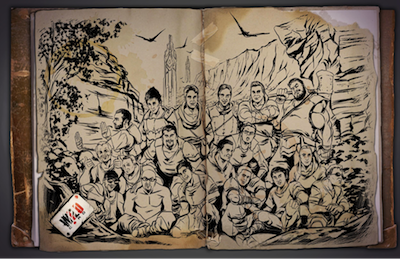Presented by SMU Guildhall
What does it take to become a successful video game designer—and how can an advanced degree help you succeed in game design? SMU Guildhall alumnus Navin Supphapholsiri ’13, a Senior Producer at Studio Wildcard, shares his experiences from the school that tops our Top Graduate Programs for Game Design ranking list. Learn how Southern Methodist University helped shape Navin’s success and lay the foundation for a successful career designing and building video games.
About the Video Game
Q: Tell us about the video game you helped design and the team of game designers behind its success.

Studio Wildcard Roster during the Launch of ARK: Survival Evolved, July 2015
A: My name is Navin Supphapholsiri and I’m a Senior Producer at Studio Wildcard. I graduated from SMU Guildhall in 2013 and have been working on ARK: Survival Evolved for the past 3 years. ARK is an open-world dinosaur sandbox survival game and is available on PC, Xbox One, and Playstation 4. ARK was one of the most successful games that came out of the Steam Early Access program, and more than 11 million copies have been sold on all platforms.
The initial launch of game on Steam Early Access consisted of a small core team of members (15 or so individuals). We worked with various contractors all over the world and combined all the work in-house inside of one of the co-founder’s living room.
As the game grew in popularity with the release of Xbox and PS4 versions, the team doubled in size by the end of 2016 to keep up with demand, adding additional team members which included graduates of SMU Guildhall . Due to the small size of the team, everyone had to wear multiple hats and take on many different responsibilities. The SMU Guildhall alumni on the ARK team were well versed in the style and pace of the industry and able to adapt well, as their graduate school training included how to develop in various team sizes and structures.
By the end of 2017, the amount of developers working on the ARK IP grew to almost 80 people. We launched 2 DLCs (Scorched Earth and Aberration), shipped the game in retail stores all over the world, and have huge plans for ARK in 2018.
Q: How did you come up with the idea for this video game?
A: We took a look at the current gaming market and noticed that there weren't any strong dinosaur games out there. We felt the best way to build around this concept was through the survival genre, which was one of the largest growing genres at the time. Games like DayZ, Rust, and Minecraft were on the rise, and we felt like we could hit a good timing window within our development schedule. Fortunately for us, there weren’t any big name titles or competitors that released that entire Summer of 2015 and we were able to dominate our genre and market for a few strong months. In addition, we timed our release around the opening of Jurassic World movie, which helped boost our sales.
”My recommendations to students interested in studying game development would be to work hard, have an open mind, be patient, and become a team player.”
— Navin Supphapholsiri, SMU Guildhall 2013, Senior Producer at Studio Wildcard
How Graduate School Helps a Career in Video Game Design
Q: What about your graduate school experience helped you most in your game design career, and in creating this video game?
A: Everything I learned at SMU Guildhall and my experience there helped me in my role with the game’s development. The program provided me with the resources to learn and adjust to industry practices.
SMU Guildhall has been ranked #1 for the past two years and has placed within the Top 10 since it was created because of the preparation it provides, the industry-driven curriculum, and the experience of its professors. The professors are experienced industry veterans who have worked on hundreds of prestigious titles that we know and love. They share the same passion as we do and understand what we are going through as we begin our journey into the world of game development. The training prepares you well for the real world. From the specialized classes to the team game projects, the Guildhall emulates everything that industry professionals experience in their careers.
My favorite moments at SMU Guildhall were during the Team Game Projects, where we would divide up into groups and work on creating games from concept to completion. The projects lasted between 2-6 months and were done in either the Unity or Unreal engine. These experiences were able to simulate the same industry processes that include dealing with the drama, conflicts, technical hurdles, and limited resources in a safe environment where it was ok to fail and improve from obstacles encountered.
Q: What advice would you offer to students interested in a master’s degree in game design to help advance their career? What should they look for in a game design program?
A: My recommendations to students interested in studying game development would be to work hard, have an open mind, be patient, and become a team player. Look at professional games and try to understand what they are doing and try to apply it to your own work. Be ready to do work and research outside of class to improve your craft. Also, understand that even if you are getting a solid education that prepares you well for the industry, it is still up to you to get a job.
Remember to keep learning and fighting for what you are passionate about. When it comes to choosing a program I would look at its faculty, attendance, placement, and games and projects completed. SMU Guildhall students graduate with a robust, competitive portfolio including three or more commercial quality games.
Additionally, look at the career success of its graduates. Guildhall alumni typically achieve senior or lead roles within 4 to 7 years after graduation and start their careers at the same level as a developer with 2 or more years of experience.
Explore Graduate Programs for You
Explore our featured graduate schools & programs to find those that both match your interests and are looking for students like you.
Best Law Schools
Check out our complete list of 168 law schools, based on surveys of school administrators and over 17,000 students.
Search for Medical Schools
Our medical school search allows you to refine your search with filters for location, tuition, concentrations and more.

Find MBA Programs Matched to Your Interests
Explore our featured business schools to find those that are looking for students like you.


